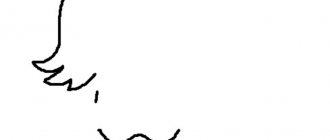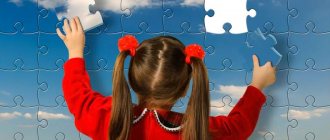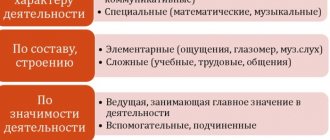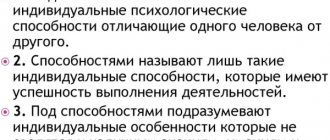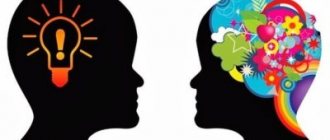Creativity is needed not only where its need is obvious, for example, in art, design, and the field of invention. It is very useful in everyday life - when you need to solve some problem or problem, when the beaten path has already set your teeth on edge and causes boredom, when you need to modernize something that already exists or quickly find a way out of an unusual situation. In our selection you will find answers to questions about how to develop creativity and improve creative abilities, what methods and techniques are available for developing creativity, and some others.
1
21 exercises to develop creativity
Creative thinking is necessary not only for artists and musicians, but also for ordinary people. With its help, you can come up with non-standard ideas that will make your work easier, increase your income and win people's recognition. In this article, we will look at 21 exercises for developing creativity, which include associations, unexpected connections, non-standard uses, etc. It is quite possible that you are already familiar with some of it, but we are still sure that you will be able to learn something new and unusual for yourself. Read more…
2
Creative people - what are they like?
The psychology of creativity is a huge basis for reflection, analysis and study of an individual with this line of thinking. These are interesting people with a rich inner world, a very unusual view of what is happening around them. They often have a good career, making progress in it. They have a large social circle. But they also have negative characteristics.
Note! Social research shows that creative people are more likely to have negative qualities, in contrast to the average individual.
Definition and characteristics of a creative person
In psychology, the concept of creativity is a type of thinking characteristic of people who have a penchant for a creative approach to solving problems. This is a creative direction, the main task of which is to search for completely new paths to the goal, which often leads to the emergence of unique ideas and discoveries.
A synonym for creativity is giftedness, but this is not always a good quality, since such people know their worth and often inflate it in the process of communicating with others. Statistics show that most often these are impudent people with virtually no modesty. Thanks to their rich imagination, creative people often and colorfully lie, since they themselves are not the most gullible representatives of society.
Main differences from non-creative people
People prone to creative thinking have their own culture, atmosphere, and methods of communication. They stand out from the crowd in many ways: from their appearance to their behavior. It is noteworthy that such people always remain children at heart. Although this does not make them irresponsible and indecisive, on the contrary, they have a lot to learn. This is their specialty.
Meeting creative people will never be a chore. No matter how the interlocutor imagines his creative friend, the other will always find something to surprise. In communication, such people more often listen to the voice of the heart than the mind.
Characteristics and Factors of Creativity
To develop your creative thinking, it is important to understand what factors exist for the development of creativity. After all, human creativity is a heterogeneous property that has several characteristics. In this article we will tell you how to assess a person's creative abilities, and also consider the key characteristics and factors of creativity. The most common properties of creative thinking are the characteristics identified by the famous American psychologist Joy Paul Guilford back in the 60s of the last century. We will focus on them. Read more…
4
Not a made up story
My close friend Mikhail worked as an ordinary middle manager. He didn’t particularly like his work, but it brought income and was a kind of “duty.” Wood carving brought real joy to Misha's life. But he pursued his hobby from time to time, and there were no bright ideas for creating masterpieces.
Everything changed when my friend began to purposefully develop his creative streak! Inspiration came to him, and he created several amazing products at once. Now Mikhail is a woodcarver, in demand and successful!
Useful video on how to develop creative thinking:
Deadly sins of creativity
A creative person is not only a poet or musician. Every person has this potential, developed to one degree or another. Even if you are not directly involved in creativity, developing creativity will help in solving many problems. Thanks to this kind of thinking, life becomes brighter and richer, happier, if you like. In fact, everything that surrounds us was created with the help of creativity of one level or another. And, of course, the question arises: why yesterday we were full of ideas, but today we cannot produce a single intelligible or original thought? This question has been studied for many years, but a complete answer has not yet been found. However, there are some observations that we want to share. Read more…
5
How to write a term paper on speech therapy
07.09.2010 243163
These guidelines are compiled to help students gain an understanding of the content and structure of coursework in speech therapy.
Logopedia of pedagogical science that studies anomalies of speech development with normal hearing, explores the manifestations, nature and mechanisms of speech disorders, develops the scientific basis for overcoming and preventing them means of special training and education.
The subject of speech therapy as a science is speech disorders and the process of training and education of persons with speech disorders.
The object of study is a person suffering from a speech disorder.
The main task of speech therapy as a science is the study, prevention and elimination of various types of speech disorders.
Coursework in speech therapy is a student's scientific and experimental research. This type of educational activity, provided for by the educational and professional program and curriculum, contributes to the acquisition of skills in working with literature, analyzing and summarizing literary sources in order to determine the range of insufficiently studied problems, determining the content and methods of experimental research, processing skills and qualitative analysis of the results obtained. The need to complete coursework in speech therapy is due to the updating of knowledge concerning the content, organization, principles, methods and techniques of speech therapy work.
As a rule, during their studies, students must write two term papers - theoretical and practical.
The first course work should be devoted to the analysis and synthesis of general and specialized literature on the chosen topic. Based on this analysis, it is necessary to justify and develop a method of ascertaining (diagnostic) experiment.
In the second course work, it is necessary to provide an analysis of the results obtained during the ascertaining experiment, as well as determine the directions and content of speech therapy work, and select adequate methods and techniques of correction.
So, let’s present the general requirements for the content and design of coursework in speech therapy.
The initial and most important stage of working on a course project is the choice of a topic, which is either proposed by the supervisor or chosen by the student independently from a list of topics that are consistent with the areas of scientific research of the department.
Each topic can be modified, considered in different aspects, but taking into account a theoretical and practical approach. Having chosen a topic, the student needs to think through in detail its specific content, areas of work, practical material, etc., which should be reflected both in the formulation of the topic and in the further construction of the study. It should be recalled that the chosen topic may not only have a purely theoretical orientation, for example: “Dysarthria. Characteristics of the defect”, “Classification of dysgraphia”, but also take into account the practical significance of the problem under consideration, for example: “Speech therapy work on speech correction for dysarthria”. It should also be taken into account that when formulating a topic, excessive detail should be avoided, for example: “Formation of prosodic components of speech in preschoolers of the sixth year of life attending a preschool institution for children with severe speech impairments.”
The course work includes such mandatory parts as: introduction, three chapters, conclusion, bibliography and appendix.
The text of the term paper begins with the title page . An example of its design can be seen here.
Then the content of the work is given, in which the names of chapters, paragraphs, and sections are formulated in strict accordance with the content of the thesis. An example of its design can be seen here.
In the text, each subsequent chapter and paragraph begins on a new page. At the end of each chapter, the materials are summarized and conclusions are formulated.
The introduction reveals the relevance of the problem under consideration in general and the topic being studied in particular; the problem, subject, object, and purpose of the study are defined. In accordance with the goal and hypothesis, objectives and a set of research methods aimed at achieving the objectives must be defined.
The relevance of the topic lies in reflecting the current level of pedagogical science and practice, meeting the requirements of novelty and usefulness.
When defining the research problem, it is important to indicate what practical tasks it will help to implement in training and educating people with speech pathology.
The object of research is understood as certain aspects of pedagogical reality, perceived through a system of theoretical and practical knowledge. The ultimate goal of any research is to improve this object.
The subject of research is some part, property, element of an object, i.e. the subject of research always indicates a specific aspect of the object that is to be studied and about which the researcher wants to gain new knowledge. An object is a part of an object.
You can give an example of the formulation of the object, subject and problem of research:
– The object of the study is the speech activity of preschool children with phonetic-phonemic speech disorders.
– The subject of the study is the features of intonation speech of children with phonetic-phonemic speech disorders.
– The research problem is to determine effective directions for speech therapy work on the formation of intonation expressiveness of speech in the system of correctional intervention.
The purpose of the study contributes to the specification of the object being studied. The goal of any research is to solve a specific problem. The goal is specified in tasks taking into account the subject of research.
The research objectives are formulated in a certain sequence, which determines the logic of the research. The research objectives are set on the basis of a theoretical analysis of the problem and an assessment of the state of its solution in practice.
The first chapter is an analysis of literary sources, which examines the state of this problem in historical and modern aspects, and presents the most important theoretical principles that formed the basis of the study.
When writing the first chapter, you should pay attention to the fact that the text of the course work must be written in a scientific style. When presenting scientific material, it is necessary to comply with the following requirements:
– Specificity – a review of only those sources that are necessary to disclose only a given topic or solve only a given problem;
– Clarity – which is characterized by semantic coherence and integrity of individual parts of the text;
– Logicality – which provides for a certain structure of presentation of the material;
– Reasoning – evidence of thoughts (why this and not otherwise);
– Precision of wording, excluding ambiguous interpretation of the authors’ statements.
A literary review of the state of the problem being studied should not be reduced to a consistent presentation of literary sources. It should present a generalized description of the literature: highlight the main directions (currents, concepts, points of view), analyze in detail and evaluate the most fundamental works of representatives of these directions.
When writing a work, the student must correctly use literary materials, make references to the authors and sources from which the results of scientific research are borrowed. Failure to provide required references will reduce your coursework grade.
As a rule, in coursework on speech therapy, references to literary sources are formatted as follows: the number of the cited source in the general list of references is placed in square brackets. For example: General speech underdevelopment is a speech pathology in which there is a persistent lag in the formation of all components of the language system: phonetics, vocabulary and grammar [17].
When using quotations, in square brackets, in addition to indicating the source number, the page number from which this excerpt is taken is indicated, for example: Speech rhythm is based on a physiological and intellectual basis, since, firstly, it is directly related to the rhythm of breathing. Secondly, being an element that performs a communicative function, “correlates with meaning, i.e. controlled intellectually” [23, P.40].
However, course work should not be of a purely abstract nature, so you should not abuse the unreasonable abundance of citations. Quoting should be logically justified, convincing and used only when really necessary.
In the second chapter , devoted to experimental research, the organization should be described and the program of the ascertaining experiment should be presented. The survey methodology, as a rule, consists of a description of several series of tasks, with detailed instructions, visual and lexical material, the procedure for completing tasks by experiment participants, and scoring criteria. This chapter also provides a qualitative and quantitative analysis of the results obtained.
When analyzing the results of an experiment, it is necessary to use a scoring system. Examples of various criteria for quantitative and qualitative assessment are presented in the following works:
– Glukhov V.P. Formation of coherent speech in preschool children with general speech underdevelopment. - M.: Arkti, 2002. - 144 p.
– Fotekova T.A. Test methodology for diagnosing oral speech of primary schoolchildren. - M.: Arkti, 2000. - 56 p.
– Levchenko I.Yu. Pathopsychology: Theory and practice. - M.: Academy, 2000. - 232 p.
In order to visually present the results obtained during the experimental study, it is recommended to use tables, graphs, diagrams, etc. Histograms can be used in a variety of ways - columnar, cylindrical, planar, volumetric, etc. An example of the design of tables, figures, and histograms can be found here.
The third chapter provides a rationale for the proposed methods and techniques and reveals the content of the main stages of correctional work.
The conclusion contains a summary of the material presented and the main conclusions formulated by the author.
The bibliography must contain at least 25 sources. The list includes bibliographic information about the sources used in preparing the work. An example of its design can be seen here.
In the application you can present bulky tables or illustrations, examination protocols, observation records, products of activity (drawings, written works of children), notes from speech therapy classes, etc.
The volume of one course work must be at least 30 pages of typewritten text.
In general, coursework in speech therapy is the basis for a future thesis, in which the study of the begun problem can be continued, but from the standpoint of a different approach or a comparative analysis of the disorders being studied in different age categories of people with different types of speech disorders.
The content and format of theses in speech therapy can be found here.
Literature:
1. How to write a term paper on speech therapy: Methodological recommendations. Educational and methodological manual / Comp. Artemova E.E., Tishina L.A. / Ed. Orlova O.S. – M.: MGOPU, 2008. – 35 p.
2. Research work of students in the system of higher professional pedagogical education (specialty 031800 - Speech therapy). Methodological recommendations for completing the thesis / Compiled by. L.V. Lopatina, V.I. Lipakova, G.G. Golubeva. - St. Petersburg: Publishing house of the Russian State Pedagogical University named after. A. I. Herzen, 2002. - 140 p.
Rules for developing creativity from Julia Cameron
Today, developed creative thinking and creativity have come to be considered almost the main qualities of a successful person. There are two polar points of view on the nature of creativity. According to the first of them, creative abilities are inherent to one degree or another in any person. According to the second theory, creativity is an “elite” quality that “chosen”, gifted people can boast of. You can accept one point of view or another. But if you believe in yourself and that there is no limit to perfection, develop your creativity. How? Using online lessons, special trainings, webinars or books by Julia Cameron. Read more…
6
Attitude to life of a creative person
Creative abilities - what is it in psychology
It is impossible to unambiguously describe the attitude to life of a creative figure. He is dreamy by nature. He sees inspiration around him, new ideas, aspirations, and discoveries arise in him. At the same time, these people rarely recognize their creations; usually the work performed does not please such a person, and at other times even leads to depression.
Failure as an impetus for action
Note! For all their outward positivity, it is creative people who are more prone to various types of depression.
However, it often happens that it is the negative phenomena in the life of the creator that push him to intensive work, into which he plunges headlong.
Exercises that will awaken your creativity
You don't have to be Picasso or Mozart to start creating. Creativity can give a lot of wonderful emotions and relieve stress, so it is valuable in itself. It has even been scientifically proven that creative activity has a positive effect on the emotional state, harmonizes the inner world and puts thoughts in order. In this article you will find several exercises that will awaken your creativity. Master and use it for your benefit at any convenient time. Read more…
8
Personal space of a creative person
Personal space is a controversial issue in the understanding of creative people. Much depends on the character of the individual.
Note! Society often dislikes creative people for violating their personal space.
Representatives of the creative world are often open and positive, at least outwardly. They are willing to make contact; if they notice something interesting about their interlocutor, they are ready to touch him with their hands up and down. They often treat their personal space calmly and tolerantly. The only period when it is worth leaving the creator alone is the peak of his active activity.
How to pump up your creative muscles. 50 Shades of Creativity: Infographic
Most people think that creativity is not about them because they can't come up with a brilliant idea or because they think they aren't creative. It is not true! Creativity is not a divine gift. This is a quality that is present in everyone's life. And in yours too. And even if someone once told you that you and creativity are incompatible things, or instilled in you the idea that you are incapable of creative feats, he was clearly wrong. You get creative dozens of times a day. But to be creative, you need practice, and in this article we will tell you in an interesting and exciting way what it should be. Read more…
9
How to communicate with a creative person
Human character traits - what they are, their description and characteristics
Having met a creative person, it is worth remembering that such a person tends to perceive life positions differently and stubbornly adhere to his reality, beliefs and views. In the art of communicating with her, it is recommended to adhere to the “Three Ps” rule:
- Adjust. Society has still not decided on the truth of the phrase “people don’t change,” but we can say with absolute confidence: a representative of creativity cannot be changed. If someone wants to continue communicating with such a person, he can only adapt to his habits and character;
- Understand. Considering the unconventional thinking of such people, you should not try to convince them of anything; it’s easier to try to understand why they think this way and not otherwise;
- Forgive. In general, these are kind, unselfish people, but they can be harsh or too passionate about their occupation. If they expressed themselves incorrectly or forgot something important, you shouldn’t hold a grudge against them.
Problems in communicating with a spiritual person
A creative character is independent in everything, he is used to relying on himself. When communicating with such an individual, you should be prepared for the fact that he may be offended or offend his interlocutor with common interests. Considering how much such people like to dream, it happens that the creator has already “experienced” some dialogue in his head that did not happen in reality, and behaves appropriately. Such moments are difficult to catch, understand, explain, and getting answers from such a person can be difficult.
Ways to be more creative
Today, creativity as a trait and skill is highly valued. This happens because creativity is about solving problems and finding ways around obstacles. It will come in handy during an interview to show yourself as an outstanding worker who can cope with tasks. In the company of friends you won't get bored. And in business, everything is often built around non-standard solutions and new ideas. Therefore, in our time, being creative is not fun, but rather a vital necessity. We bring to your attention ways in which you can increase your creative level. Read more…
10
11 Practical Tricks to Improve Creative Thinking
“Creative thinking is not a talent, it is a skill that can be learned.
It empowers people, enhancing their innate abilities, which improves teamwork, productivity and, where appropriate, profits.” Edward de Bono
#1. You need empowering rituals.
One of the best ways to inspire yourself and create every day is to develop rituals that you use regularly. This will prepare your brain to be creative.
For example, your ritual could be reading in the morning, listening to music, meditating for a few minutes, or taking a few deep breaths.
#2. Try to create something every day
Create something every day, even if it only takes 5 or 10 minutes. Try writing articles, drawing mind maps, developing business models, concepts, and collecting and developing ideas.
#3 – Don't be disciplined, be dedicated
Luciano Pavarotti once said: “People think I am disciplined. This is not discipline, but devotion. There is a big difference between them."
#4. Take breaks.
When you feel stuck with an idea and are at a dead end, take a break. Trying to force yourself to find a solution will only lead to exhaustion.
We recommend reading → How to live correctly or 100 tips on how to make your life better
Try getting up from your desk, going outside or to the vending machine, getting a coffee, talking to people, and looking at the scenery outside your desk.
Some ideas will strike you in the most unexpected places, and you will be surprised that you found a solution to a problem even though you didn't work on it.
A person's creative abilities can manifest themselves at any moment.
#5 – Make a list and evaluate your ideas
Sometimes the opposite of writer's block happens - you just have too many ideas! While this is good, it can be confusing.
You can sort your thoughts by making lists. Write down every idea that comes to your mind and determine which one you think is best.
#6. Ask the right questions
Whenever you need to get creative, always start with the “why, how, what, when” questions and try to answer them.
#7. Have fun with colleagues or friends
Having fun with colleagues or friends is a proven and popular way to generate ideas. This is a great time to open yourself to the thoughts of others in order to refine your ideas.
The best way to do this is to listen to ideas without judgment. Judging an idea without even hearing the full concept will create hostility within the company. This is how the development of creative abilities does not occur.
#8. Use rush hours
Some people are more creative and productive at certain times of the day, while others are more creative at the peak of their emotions. Get creative in this moment and let your creative juices flow freely.
Creativity can also be improved if you create in a specific place or if you surround yourself with certain music.
This method works differently for everyone. Decide what time of day, emotions or environment you need to create to make it easier to create. Just do what works for you.
#9. Build a network
Attract creative and inspiring people into your social circle and communicate with them regularly. By listening to new perspectives and looking at your problems from different angles, you can improve your ideas.
An outside perspective will help you understand the problem and find solutions.
#10. Take risks
Risk can be a double-edged sword, but the more you avoid it, the more you leave your ideas unchanged.
Risks allow you to think outside the box and look for unconventional ways to solve a problem. Creative thinking doesn't require you to conform to the norm. In fact, most brilliant concepts are born from various deviations.
Online program “TRIZ in practice”
In 4 weeks of this program, you will evaluate your creative abilities and learn ways to develop them, learn to apply creative and inventive algorithms. This will help you solve non-standard problems not only in everyday life, but also in other areas: from science and education to art and business. The emphasis is on the practical application of creative algorithms in the humanities and business. Everything is told in simple language with examples and step-by-step instructions. And tests, cases, games and exercises will train the ability to apply creative algorithms in life. Find out more...
Friends, always believe in yourself, unlock your potential and look for new opportunities to express it. Believe me, this will definitely be useful to you, and we are sure that you will succeed. Good luck!
We also recommend reading:
- Storytelling
- Developing creativity: a selection of useful materials
- Secrets of inventors: a selection of useful materials
- Design thinking for all occasions
- 21 exercises to develop creativity
- A selection of useful materials about creativity and creativity development
- Deadly sins of creativity
- 6 Creativity Killers
- How to pump up your creative muscles. 50 Shades of Creativity: Infographic
- Invention: a selection of useful materials
- Creativity Development Digest
Key words:1TRIZ
Better Creative Thinking Skills
Next, let's look at what skills are needed to develop creative abilities?
#1. Analysis
Before you can think about anything creatively, you must be able to understand it. This requires the ability to carefully examine things in order to comprehend their true meaning. If you are looking at a text, a set of data, a lesson plan, or an equation, you must first analyze it.
#2: Keep an open mind
Creativity and developing creativity involves thinking about things differently within the context in question.
You must put aside any assumptions or preconceptions you may have and look at things in a completely new way. By approaching a problem with an open mind, you give yourself the opportunity to think creatively.
#3. Problem solving
Nobody wants to associate with creative people just because they impress. The world needs people who can solve problems.
Therefore, it is important to emphasize not only your ability to think creatively, but also to use your creativity to solve important problems.
#4. Stay organized
This may seem counterintuitive: aren't creative people known for being disorganized? In fact, being organized is an important part of creativity.
Although you may be a bit of a cluttered thinker, when you come up with a new idea, you need to articulate it in a way that other people can understand and implement your vision. Being able to create an action plan with clear goals and timelines is vital.
#5. Communications
People will only appreciate your creative idea or solution if you can effectively communicate it to them. Therefore, you need to have strong written and oral communication skills.
You also need to be able to think about a situation fully before thinking about it creatively. Therefore, you also need to be a good listener. By asking the right questions and understanding the problem, you can find a unique solution.
Learning to develop imagination by observing the world around us
Take a walk in the park, get out of town, teach your child to admire the beauty of the world around him. It’s interesting to come up with images while looking at clouds, or to guess objects by their outlines late in the evening. If you take a magnifying glass or binoculars with you, observing birds and insects will be even more interesting.
Artist Rob Sayaj Jr. uses a tablet to create these cloud paintings.
Arm yourself with a whiteboard marker (it washes off easily) and try to draw your own shapes on the glass with your child.
Creativity is accessible to everyone
To learn to think creatively, you need to practice. Not everything works out right away, but that’s not a problem: there are no those who have become masters of their craft without any effort.
The good thing about creativity is that it can be inexpensive or even free. Using pebbles, you can turn a milk carton into a musical instrument, make a flower out of a napkin, or make a box out of popsicle sticks. It would be a fantasy!
Simple materials give the child a lot of room for creativity.
We save the results and the desire to create
Children are upset when they find out that their crafts and drawings are thrown away. Therefore, collect and store children's creativity. These are mementos for you and a source of inspiration for your child. And in 15-20 years, yesterday’s scribbles can also mature and grow into professional art.
Children's drawings by artists in a new version. Work by Katherine Brannock
You cannot criticize (,) (,) praise
The child wanted to draw a horse, but a dog came out? Has a pencil drawing turned into a daub after watercolor? The opinion of mom and dad is the most authoritative for the child. A word can inspire or discourage the desire to engage in creativity. Try to respond carefully to the first creative steps.
The courage to criticize must be followed by the courage to praise. Honore de Balzac
Let's dive into art
Introduce your child to literary and musical classics, instill a love of reading books. Instead of toys or goodies, you can buy tickets to the theater, cinema or art exhibition. A change of scenery, going to an unfamiliar place will bring new emotions, joy and inspiration. Art in its purest form is a good teacher, capable of awakening in a child the desire to create his own masterpieces.
Exercise "What if..."
Take a fairy tale as a basis and change one detail in the plot (for example, Little Red Riding Hood did not tell the wolf where her grandmother’s house was). Imagine how the plot of the fairy tale would develop further.
A good book will keep children company and teach them to dream.
Setting up a creative corner
We found the source - we create the conditions. The problem of a carpet stained with plasticine and painted wallpaper will be solved by a specially equipped creative corner. Let your child take a break from the outside world and immerse himself in his favorite hobby, without fear of being punished for making a mess or ruining things.
A place for children's creativity may resemble the aftermath of a hurricane, but you should be able to close your eyes to this. “No chaos - no inspiration. “It’s like a kitchen during lunch,” said American philologist and writer Mason Cooley.
Embrace clutter as part of creativity.
Creating conditions and atmosphere is important. Even more important is to develop the desire to create and find sources of inspiration.
